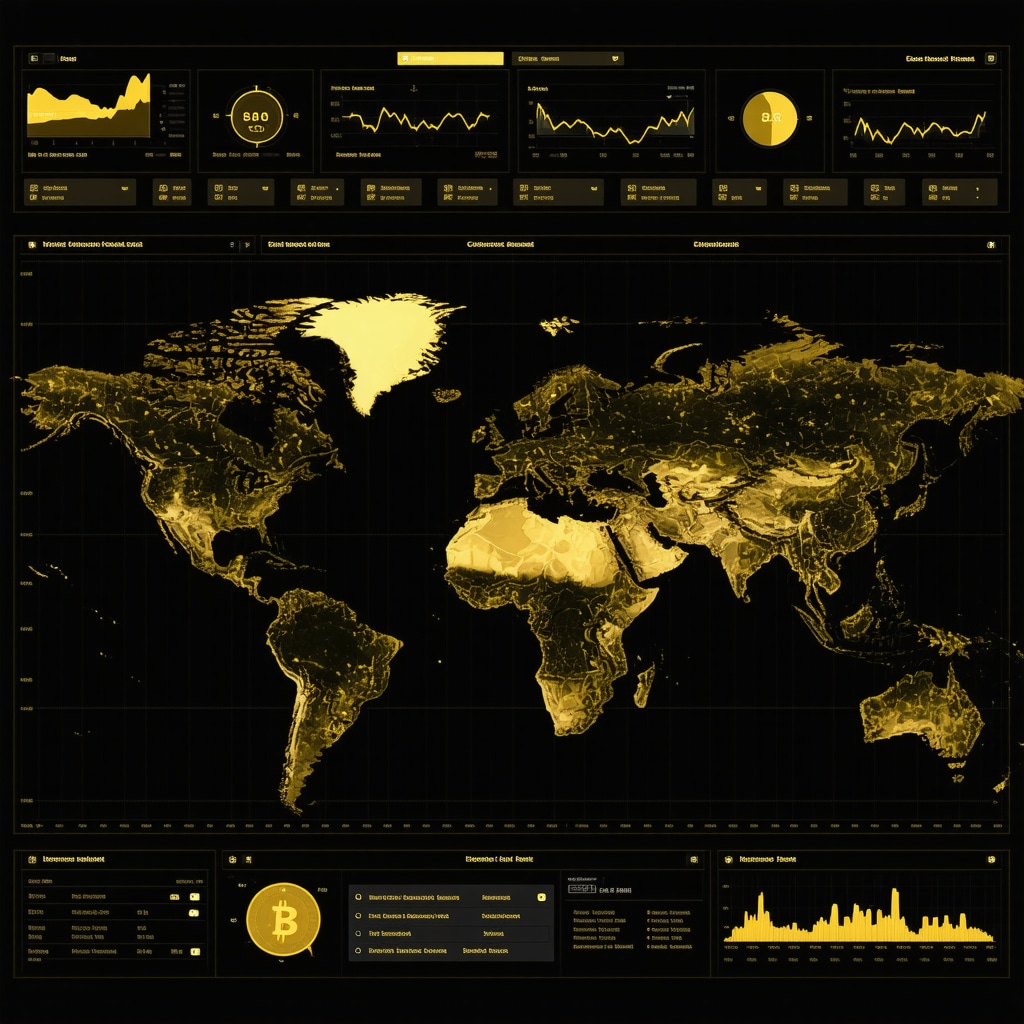Strategic Dynamics of Central Bank Gold Acquisition in 2025
Central banks’ gold purchasing strategies remain pivotal in shaping global market demand, particularly as geopolitical tensions and economic uncertainties persist. In 2025, these institutions are not merely stockpiling gold as a reserve asset; they are actively influencing price trajectories and liquidity within the precious metals markets. The nuanced interplay of monetary policy, currency diversification, and strategic reserve management elevates central bank gold buying from a passive hedge to an assertive economic signal.
Decoding the Latent Impact on Global Gold Demand and Pricing
Central bank acquisitions contribute significantly to the physical demand for gold, often accounting for a substantial portion of annual consumption. This demand surge exerts upward pressure on prices, especially when juxtaposed with constrained mining supply and fluctuating investor sentiment. The effect is compounded by the central banks’ role in signaling confidence or concern regarding fiat currencies, thus affecting private sector investment and jewelry demand in a cascading manner.
How Do Central Bank Gold Purchases Shape Market Liquidity and Investor Behavior?
Market liquidity is intricately influenced by central bank transactions. Large-scale acquisitions can reduce available supply in the open market, thereby tightening liquidity and fostering price volatility. Investors interpret these moves as indicators of macroeconomic stability or risk, adjusting their portfolios accordingly. For example, when central banks increase gold reserves amidst inflationary outlooks, it often prompts a reallocation toward gold ETFs and physical bullion among institutional and retail investors alike. This behavioral response underscores the interconnectedness of central bank policies and broader market dynamics.
Emerging Trends: Central Bank Diversification and Its Ripple Effects
Recent years have witnessed a strategic diversification by central banks away from the US dollar toward gold and other assets. This trend continues in 2025, influenced by shifting geopolitical alliances and a desire to hedge against currency devaluation. The resultant increase in gold demand is nuanced, affecting not only price levels but also the physical market’s supply chain dynamics. Countries with significant gold reserves leverage these assets to bolster monetary sovereignty, which in turn impacts global liquidity and trade flows.
Integrating Central Bank Activity with Broader Gold Market Insights
Understanding central bank gold buying patterns is crucial for investors aiming to optimize timing and portfolio composition. For a deeper exploration of gold demand trends and their investment implications, readers should examine comprehensive analyses such as those found in Analyzing Global Gold Demand Trends Impacting Prices in 2025. Such insights provide critical context for navigating the complexities introduced by central bank behavior.
Expert Reflection: What Are the Long-Term Implications of Central Bank Gold Buying for Global Financial Stability?
Central bank gold buying is more than a tactical reserve adjustment; it is a strategic maneuver with profound implications for global financial stability. Sustained accumulation can signal mistrust in existing monetary frameworks, prompting shifts toward gold-backed assets and alternative currencies. This dynamic fosters a reconfiguration of global capital flows and may accelerate the emergence of new reserve currency paradigms. The long-term effects hinge on coordinated policy responses and market adaptability.
For investors and market analysts seeking to deepen their understanding of gold trading nuances and maximize returns amidst such central bank-driven market shifts, exploring advanced strategies is imperative. Resources like Mastering Gold Trading Techniques for Consistent Profit in 2025 offer expert guidance tailored to current market realities.
Authoritative data on central bank gold reserves and market impact can be further reviewed through the World Gold Council’s comprehensive reports, which provide empirical underpinning to these strategic insights (World Gold Council – Central Bank Reserves Data).
Leveraging Central Bank Gold Purchases for Strategic Portfolio Diversification
Investors aiming to harness the full potential of gold in their portfolios must consider the profound influence of central bank gold buying on market dynamics. Central banks’ accumulation patterns often preempt shifts in inflation expectations, currency valuations, and geopolitical risk appetites, thereby serving as a barometer for strategic asset allocation. Incorporating this intelligence into portfolio design can enhance risk-adjusted returns by timing entries and exits aligned with central bank activity.
Advanced Analytical Tools to Monitor Central Bank Gold Movements
With the complexity of gold market drivers in 2025, sophisticated monitoring frameworks are essential. Leveraging real-time data analytics, sentiment analysis, and geopolitical risk indicators can provide early warnings of central bank interventions. Platforms aggregating central bank reserve updates, combined with predictive modeling of macroeconomic indicators, empower investors to anticipate supply-demand imbalances and price inflections. These tools are invaluable for both short-term traders and long-term holders seeking to optimize timing and exposure.
Can Integrating Central Bank Gold Acquisition Data Improve Predictive Accuracy in Gold Price Forecasting?
Indeed, incorporating granular central bank gold purchase data enhances the precision of price forecasts. By analyzing trends in reserve diversification and correlating them with macroeconomic variables, sophisticated models can capture subtle market signals often overlooked by traditional analysis. This integration supports better risk management and decision-making frameworks, especially amid volatile or inflationary environments. Investors who incorporate these insights can achieve a competitive edge in anticipating price movements and adjusting their gold holdings accordingly.
Case Study: Central Bank Gold Buying Patterns and Their Ripple Effects on Gold ETFs and Physical Bullion
Central bank purchases not only affect physical gold supply but also indirectly influence gold-backed exchange-traded funds (ETFs). When central banks increase reserves, they effectively remove significant quantities of gold from the market, tightening availability and driving premiums. This scarcity often pushes investors toward gold ETFs as an accessible alternative, impacting ETF flows and pricing dynamics. Understanding this interplay is critical for optimizing investment strategies across gold vehicles.
Practical Considerations for Investors Navigating Central Bank-Driven Market Changes
Investors should remain vigilant of central bank disclosures and geopolitical developments influencing gold reserves. Timing purchases during periods of reported accumulation or after shifts in monetary policy can improve entry points. Moreover, diversifying across physical gold, ETFs, and mining stocks can mitigate risks associated with supply chain disruptions or regulatory changes. For an in-depth guide on building a resilient gold investment portfolio that accounts for these factors, see How to Build a Gold Investment Portfolio for Steady Returns.
Authoritative insights on central bank gold buying trends and their market impact are extensively documented by the World Gold Council, offering data-driven perspectives essential for informed investment decisions.
Engage with Us: Share Your Perspectives and Strategies on Central Bank Gold Influence
How have central bank gold buying patterns influenced your investment approach in 2025? We invite readers to share their experiences, strategies, or questions in the comments below to foster a richer dialogue. Additionally, explore more expert analyses and strategic advice on related topics like Mastering Gold Trading Techniques for Consistent Profit in 2025 to sharpen your market acumen.
Decoding the Nuances of Central Bank Gold Buying Impact on Market Sentiment and Volatility
The intricate relationship between central bank gold purchases and market sentiment often remains underestimated by many investors. Beyond the immediate supply-demand mechanics, these acquisitions communicate subtle signals about economic confidence, inflation expectations, and geopolitical risk assessments. For instance, a sudden uptick in gold reserves by a major economy might reflect anticipatory measures against currency instability or impending fiscal turbulence. This psychological component amplifies volatility as market participants recalibrate risk premiums and portfolio allocations in response to perceived shifts in macroeconomic landscapes.
What Are the Advanced Analytical Approaches for Integrating Central Bank Gold Data into Predictive Gold Price Models?
Integrating granular central bank gold acquisition data into predictive models requires sophisticated analytical frameworks combining econometric techniques, machine learning algorithms, and real-time macroeconomic indicators. Time-series analysis can detect causality patterns between reserve changes and gold price movements, while sentiment analysis of central bank communications offers qualitative context to quantitative data. Advanced models also incorporate geopolitical event risk scores and currency exchange rate fluctuations to refine forecasts. Such multidimensional approaches surpass traditional correlation-based models, offering enhanced predictive accuracy and actionable insights for traders and institutional investors.
For a comprehensive methodology on applying these techniques, the World Gold Council’s research on central bank gold reserves provides an authoritative foundation.
Synergizing Central Bank Gold Buying Trends with Broader Asset Allocation Strategies
Central bank gold purchases should be viewed not in isolation but as integral signals within the broader asset allocation matrix. Dynamic portfolio management benefits from recognizing how shifts in gold reserves correlate with movements in fiat currencies, sovereign bonds, and equities. For example, a sustained increase in gold reserves amidst rising inflation expectations may warrant overweighting gold-related assets while reducing exposure to inflation-sensitive fixed income. Additionally, understanding the timing and scale of central bank interventions can guide tactical adjustments, optimizing risk-adjusted returns.
Institutional investors increasingly adopt multi-asset models that embed central bank gold reserve data as a key input, leveraging scenario analysis and stress testing to anticipate market responses under various geopolitical and economic contingencies.
Case Insights: How Central Bank Gold Buying Influences the Interplay Between Physical Bullion Demand and Gold Derivatives Markets
While central bank purchases primarily affect physical gold supply, their ripple effects extend into derivatives markets, including futures and options. By withdrawing significant physical volumes from circulation, central banks can tighten spot market supply, which often leads to increased backwardation or contango in futures pricing structures. This dynamic influences hedging costs and speculative positioning, thereby affecting liquidity and volatility across gold derivatives.
Professional traders and portfolio managers must thus integrate central bank activity data to optimize hedging strategies and arbitrage opportunities, balancing exposure between spot and derivatives markets. This nuanced understanding aids in navigating complex market environments where physical and paper gold markets exhibit divergent behaviors.
Can Monitoring Central Bank Gold Reserve Announcements Enhance Timing Strategies for Gold Derivatives Trading?
Yes, timely analysis of central bank reserve disclosures can significantly improve entry and exit timing for gold derivatives. Anticipating reserve accumulation or liquidation events allows traders to position themselves ahead of price movements, exploiting transient inefficiencies. Furthermore, coupling reserve data with macroeconomic indicators enhances situational awareness, enabling more informed speculative or hedging decisions. This strategic integration is increasingly recognized as a best practice among sophisticated market participants.
Emerging Technological Solutions for Real-Time Tracking and Analysis of Central Bank Gold Activities
In the digital age, technology-driven platforms harness artificial intelligence and big data to track central bank gold buying with unprecedented granularity and speed. These solutions aggregate public disclosures, trade data, and geopolitical news feeds to generate actionable intelligence. Predictive analytics powered by machine learning can simulate potential market impacts under varying scenarios, equipping investors with proactive risk mitigation tools.
Such platforms are revolutionizing how market participants interpret central bank signals, transforming raw data into strategic insights that align with rapidly evolving global economic conditions.
For investors aiming to stay at the forefront, exploring these technological advancements is essential to maintain a competitive edge.
Unlocking Deeper Expertise: Join Our Advanced Gold Market Strategy Webinars
To further empower your investment decisions, we invite you to engage with our upcoming webinars that delve into the complexities of central bank gold buying, advanced forecasting models, and integrated portfolio strategies. These sessions feature expert analysts and case studies designed to elevate your understanding and practical application of gold market dynamics.
Stay connected and informed by subscribing to our newsletter and accessing exclusive resources tailored for discerning investors navigating the evolving landscape of gold investment.
Unveiling the Confluence of AI and Central Bank Gold Analytics
As 2025 unfolds, the integration of artificial intelligence (AI) and machine learning into monitoring central bank gold purchases is revolutionizing market intelligence. This fusion enables the deconstruction of complex datasets—ranging from official reserve disclosures to geopolitical risk indices—yielding predictive insights with unprecedented precision. Leveraging natural language processing to analyze central bank communications alongside quantitative data enriches the contextual understanding of reserve movements, clarifying intent behind accumulation or divestment strategies.
How Can Advanced Machine Learning Models Enhance Forecasting of Central Bank Gold Buying Impact?
Advanced machine learning frameworks, including ensemble models and recurrent neural networks, facilitate dynamic forecasting by capturing non-linear interactions among macroeconomic variables, geopolitical events, and central bank activity. By training on historical patterns and real-time data streams, these models discern subtle precursors to gold price inflections driven by reserve adjustments. This capability empowers investors to anticipate market shifts with greater lead times and calibrate hedging or speculative positions accordingly, mitigating risk exposure in volatile environments.
For practitioners seeking methodological rigor, the World Gold Council’s research on central bank gold reserves offers foundational insights into the integration of econometric and AI-driven analytical techniques.
Bridging Central Bank Gold Trends with Quantitative Portfolio Optimization
Incorporating central bank gold buying data into quantitative asset allocation models can materially enhance portfolio resilience. Utilizing scenario analysis that includes anticipated central bank reserve strategies enables multi-asset optimization frameworks to dynamically adjust gold exposure relative to equity and fixed income holdings. This strategic calibration not only hedges against currency debasement and inflationary pressures but also harnesses gold’s asymmetric return profile during geopolitical upheavals, aligning with institutional objectives for risk-adjusted performance.
Emerging Paradigms: Central Bank Gold Activities and Blockchain-Verified Ownership
Blockchain technology is increasingly explored as a means to enhance transparency and traceability of physical gold holdings influenced by central bank transactions. Tokenization of gold reserves could facilitate more granular tracking of ownership changes and supply chain provenance, potentially reducing market opacity and counterparty risk. Such innovations may redefine how investors interact with gold assets, bridging the gap between physical bullion demand and digital asset ecosystems.
Synergistic Effects on Gold-Linked Derivatives and Synthetic Exposure Vehicles
Central bank gold buying patterns materially affect the supply-demand equilibrium that underpins derivatives markets, including futures, options, and gold-linked exchange-traded products. By constricting underlying physical availability, these purchases can induce heightened basis volatility and influence implied volatility surfaces, thereby affecting derivatives pricing models. Sophisticated traders must integrate real-time central bank data feeds to optimize arbitrage strategies and manage convexity risks inherent in synthetic gold exposure.
Can Real-Time Central Bank Gold Reserve Tracking Augment Algorithmic Trading Strategies?
Indeed, embedding real-time central bank gold acquisition data into algorithmic trading frameworks enhances signal fidelity, facilitating adaptive strategy adjustments in response to sudden reserve disclosures or geopolitical developments. This integration supports the deployment of high-frequency trading algorithms that capitalize on transient market inefficiencies while maintaining robust risk controls. As market fragmentation intensifies, such technological augmentation becomes indispensable for institutional-grade trading operations.
Call to Action: Elevate Your Gold Market Expertise Through Cutting-Edge Analytical Tools
To navigate the sophisticated interplay of central bank gold activities and market dynamics, investors and analysts should harness advanced AI-driven platforms and quantitative models. Engage with our expert-led webinars and subscribe to specialized analytic services that decode these complex signals, enabling informed decision-making and strategic portfolio positioning. Embrace the frontier of gold market intelligence to secure a competitive advantage in 2025 and beyond.

Expert Insights & Advanced Considerations
Central Bank Gold Accumulation as a Macro-Stability Barometer
Central banks’ gold purchasing patterns serve as a critical indicator of underlying macroeconomic confidence and geopolitical risk assessments. Their sustained acquisition signals a strategic pivot towards monetary sovereignty and hedging against fiat currency vulnerabilities, profoundly influencing global capital allocation and investor sentiment.
Integration of AI and Machine Learning for Enhanced Gold Market Forecasting
Advanced AI-driven analytical models now enable real-time synthesis of central bank reserve data with macroeconomic and geopolitical variables, delivering superior predictive accuracy. These technologies empower investors to identify subtle market inflections and optimize timing strategies beyond traditional econometric approaches.
Blockchain and Tokenization: Transforming Transparency in Gold Ownership
The emergence of blockchain-verified gold ownership introduces unprecedented traceability and liquidity to gold markets. This innovation, when combined with central bank holdings, may redefine supply chain dynamics and investor interactions, thereby affecting pricing mechanisms and reducing counterparty risk.
Strategic Portfolio Diversification Anchored in Central Bank Signals
Incorporating central bank gold buying data into quantitative asset allocation frameworks enhances portfolio resilience. It facilitates dynamic adjustments to gold exposure relative to equities and fixed income, effectively hedging inflation and geopolitical shocks while capitalizing on gold’s unique return profile.
Derivatives Market Dynamics Influenced by Central Bank Physical Gold Movements
Central bank gold purchases constrict physical supply, impacting futures and options pricing structures. Traders leveraging real-time reserve data can better navigate basis volatility and optimize hedging strategies, balancing exposure between spot and derivative instruments.
Curated Expert Resources
- World Gold Council Research Hub: Offers comprehensive analyses and empirical data on central bank gold reserves and market impacts, essential for deepening expert knowledge (World Gold Council – Central Bank Reserves Data).
- Mastering Gold Trading Techniques for Consistent Profit in 2025: An authoritative guide detailing sophisticated trading strategies aligned with central bank-driven market shifts (read more).
- Analyzing Global Gold Demand Trends Impacting Prices in 2025: Provides crucial context for understanding how central bank activity shapes broader demand and price dynamics (explore here).
- How Central Bank Gold Purchases Affect Global Markets Today: Delivers insight into the immediate market consequences of reserve changes, aiding tactical decision-making (learn more).
- Advanced Quantitative Models for Gold Price Forecasting: Discusses integration of central bank data into econometric and machine learning forecasting frameworks, enhancing market prediction capabilities (see World Gold Council research).
Final Expert Perspective
Central bank gold buying in 2025 transcends conventional reserve management, emerging as a strategic force reshaping global financial landscapes and market behavior. The intricate signals embedded in these transactions offer investors a sophisticated lens through which to anticipate macroeconomic shifts, optimize portfolio allocations, and refine trading tactics. By leveraging advanced AI analytics, blockchain innovations, and rigorous data integration, market participants can unlock nuanced understanding and competitive advantages in gold investment strategies.
We encourage readers to deepen their engagement with this evolving domain by contributing professional insights, exploring the recommended expert resources, and embracing advanced methodologies to master the complexities of central bank gold buying impact. Your informed perspective enriches the collective expertise necessary to navigate the gold markets confidently in 2025 and beyond.










